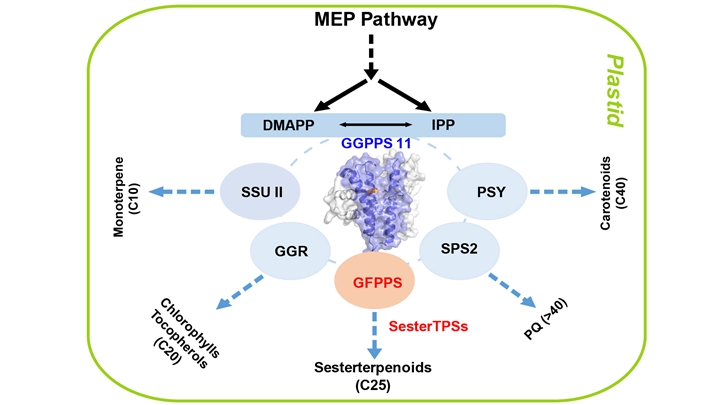Recently, researchers from WANG Guodong's group in the Institute of Genetics and Developmental Biology (IGDB), Chinese Academy of Sciences (CAS), provided genetic evidence to demonstrate that geranylfarnesyl diphosphate synthases (GFPPSs) are responsible for sesterterpene production in Arabidopsis.
Plants synthesize over 170,000 terpenoids (including phytohormones GA, ABA, STL, etc.) with diverse ecological functions to help them survive in their local environments. Despite their vast structural and functional diversity, terpenoids are de novo synthesized from only two common C5 precursors, namely, isopentenyl diphosphate (IPP) and its isomer dimethylallyl diphosphate (DMAPP). These two precursors can be generated from either of two independent pathways: the cytosolic mevalonate (MVA) pathway and the plastidial MEP pathway.
Sesterterpenes (C25), an understudied group of terpenoids, are widely distributed in the plant kingdom. Upstream enzymes, such as geranylfarnesyl diphosphate synthase (GFPPS, C25) and sesterterpene synthase (sesterTPS), have been thoroughly investigated at the biochemical level. It is noteworthy that plant GFPPSs were evolved from plant GGPPS (C20, a hub enzyme in terpene network) via gene duplication followed by neofunctionalization.
The researchers found that blockage of the sesterterpene pathway at GFPPS step increased the production of GGPP-derived terpenes. Unexpectedly, they further found that coexpression of sesterTPSs in GFPPS-OE plants rescued the phenotypic changes of GFPPS-OE plants by restoring the endogenous GGPP.
By using various techniques, they found that in addition to precursor (DMAPP/IPP) competition by GFPPS and GGPPS in plastids, GFPPS directly decreased the activity of GGPPS through protein-protein interaction. The common heteromerizations of GFPPS and GGPPS were further discovered in other plant species, however, with different biochemical outcomes.
This study not only deepens our understanding of the catalytic regulation of plastidial terpeneoid biosynthesis, but also provides materials for elucidating the physiological functions of plant sesterterpenes.
The research results were published online in Journal of Integrative Plant Biology entitled "Heteromerization of Short-Chain trans-Prenyltransferase Controls Precursor Allocation within a Plastidial Terpenoid Network".
This work is supported by grants from the National Key R&D Program of China, the National Natural Science Foundation of China, and the State Key Laboratory of Plant Genomics of China
Figure: Updated MEP-derived terpene pathways in plants. The common precursors (DMAPP and IPP) for terpene biosynthesis (monoterpene, diterpene, and sesterterpene) via the MEP pathway were generated in plastids of plant cells. The GGPPS-interacted proteins shown in bold were functionally characterized at both the biochemical and genetic levels. The physical interaction between GFPPS-GGPPS was discovered in this study. Image courtesy of Dr. WANG Guodong.
Contact:
Dr. WANG Guodong
Institute of Genetics and Developmental Biology, Chinese Academy of Sciences
 Figure: Updated MEP-derived terpene pathways in plants. The common precursors (DMAPP and IPP) for terpene biosynthesis (monoterpene, diterpene, and sesterterpene) via the MEP pathway were generated in plastids of plant cells. The GGPPS-interacted proteins shown in bold were functionally characterized at both the biochemical and genetic levels. The physical interaction between GFPPS-GGPPS was discovered in this study. Image courtesy of Dr. WANG Guodong.Contact:Dr. WANG GuodongInstitute of Genetics and Developmental Biology, Chinese Academy of SciencesEmail: gdwang@genetics.ac.cn
Figure: Updated MEP-derived terpene pathways in plants. The common precursors (DMAPP and IPP) for terpene biosynthesis (monoterpene, diterpene, and sesterterpene) via the MEP pathway were generated in plastids of plant cells. The GGPPS-interacted proteins shown in bold were functionally characterized at both the biochemical and genetic levels. The physical interaction between GFPPS-GGPPS was discovered in this study. Image courtesy of Dr. WANG Guodong.Contact:Dr. WANG GuodongInstitute of Genetics and Developmental Biology, Chinese Academy of SciencesEmail: gdwang@genetics.ac.cn CAS
CAS
 中文
中文




.png)
